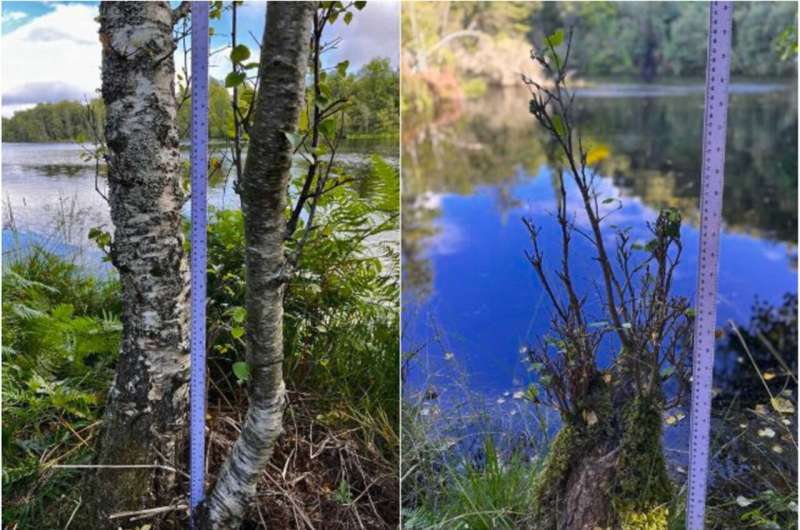This article has been reviewed according to Science X's editorial process and policies. Editors have highlighted the following attributes while ensuring the content's credibility:
fact-checked
peer-reviewed publication
trusted source
proofread
Study sheds new light on how Scotland's beavers interact with the environment

A study by the University of Stirling has shed new light on how beavers reintroduced to Scotland indirectly interact with deer—and the implications for the woodlands they share.
Researchers found that almost two-thirds of trees felled by beavers produced new shoots, which were more abundant and concentrated closer to the ground than on other trees.
This could diversify woodland structure into a mix of short and tall tree stems, which ought to boost biodiversity, according to researchers in the Faculty of Natural Sciences.
The research, which also involved researchers at NatureScot and the James Hutton Institute, was carried out in eastern Scotland in established beaver territories by studying almost 800 trees. The paper, "Tree felling by beaver promotes regeneration in riparian woodlands whilst increasing resource availability for deer," was published in the journal Forest Ecology & Management.
Scientists compared the number of shoots on beaver-felled trees to standing trees and collected 156 shoots with four different combinations of beaver and deer browsing to compare their nutrient levels and physical characteristics.
Beavers were hunted to extinction in Scotland about four centuries ago. A formal multi-agency program of reintroduction involving experts at the University of Stirling and the study partners—the first of its kind for a mammal species anywhere in Britain—began in 2009 in Argyll.
Scotland's Beaver Strategy 2022–2045 sets out the benefits and challenges of reintroduction, including environmental and economic opportunities and the need for management when necessary.
Dr. Kelsey Wilson, who led the new study as part of her Ph.D. research at the University of Stirling, said, "Beavers have gradually returned, sometimes after long absences, into riverside or riparian woodlands often shared with large populations of browsing deer.
"Beavers use their sharp teeth to cut down riverside trees of different sizes and species. Their most favored trees, such as willows, usually respond by vigorously sprouting a crown of new shoots—similar to what happens with traditional tree coppicing.
"We found that almost two-thirds of trees produced new shoots after being felled by beavers. These shoots were more abundant, nutritious, and concentrated closer to the ground than on other trees, making them an easily accessible food source for foraging deer."
Biodiversity boost
As beaver populations rise, interactions with deer are expected to become more common in riparian woodlands, which are valued for their role in reducing pollution to rivers, shading them from rising temperatures, buffering flood impacts and as a source of food for aquatic life.
Having a deeper understanding of beaver-deer interactions can help direct conservation efforts and habitat management strategies to meet national woodland creation goals in the areas where these two species overlap.
The University of Stirling's Professor Nigel Willby, a co-author of the study, said, "The way in which a woodland is structured greatly affects its biodiversity and conservation value. Our research shows that tree-felling by beavers could diversify woodland structure into a mix of short and tall tree stems, which ought to boost biodiversity overall.
"However, if more deer are attracted into riparian woodlands by the offer of a rich, accessible food source that beavers stimulate through their felling behavior, it could suppress tree growth. This might simplify woodland structure, and future woodland regeneration efforts could be hindered."
Complex role
Dr. Martin Gaywood, NatureScot's Species Projects Manager, said, "We were pleased to help support this research exploring the complex role of beavers within the Scottish environment.
"Scotland's Beaver Strategy has ambitions for wider beaver restoration across Scotland, and so the potential interactions between beavers and deer will be an important consideration in planning, decision-making and management. Where beavers have been restored to new catchments then ongoing monitoring of combined herbivore impacts in relevant woodlands is being carried out.
"Riverside woodland creation and management in the presence of beavers is a key focus of the work of the Scottish Beaver Advisory Group, and this research makes a further useful contribution to our knowledge base."
More information: Kelsey A. Wilson et al, Tree felling by beaver promotes regeneration in riparian woodlands whilst increasing resource availability for deer, Forest Ecology and Management (2024). DOI: 10.1016/j.foreco.2024.121910
Journal information: Forest Ecology and Management
Provided by University of Stirling



















